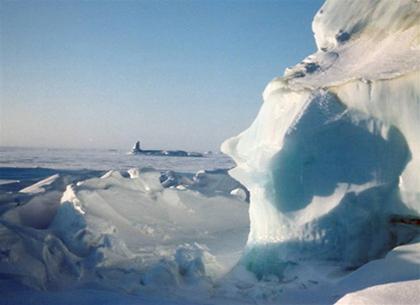Canada: Large icebergs in the Arctic drift down to the south sea
In recent weeks, on the giant ice island Ayles off the northwestern coast of the island of Elesmir in the Arctic Sea appear empty waters and large cracks due to unusual weather conditions.
The largest ice island in Canada's Arctic Sea in the past 30 years has been formed since August 2005 when a large ice seam of 66 km 2 and 30-40 m thick, exists from 3,000 to 4,500 years, separating away from Elesmir Island far away to the sea.
Canadian ice research experts say the Ayles ice island could drift down to the west or south seas by seeing a large amount of ice in the nearby Lincoln Sea melting. This phenomenon is due to the recent warm winter that failed to create a ice bridge in the Nares Strait connecting the two islands of Elesmir and Baffin Island as a large wall, preventing the Arctic ice sheets from drifting down the regions. south sea.
According to Canadian scientists, the phenomenon is likely to seriously affect maritime operations because if the Ayles ice island drifted southwest, it could be blocked in Canada's Arctic islands. or if it drifted towards the Beaufort Sea, it could affect oil exploration here. Recently, representatives of a major US oil company had to visit Canadian ice research experts to discuss the risks to their mining operations off the coast of Alaska.
Currently Canadian scientists are actively monitoring and finding effective measures to be ready to deal with the possibility of large blocks of ice from the Arctic drifting down to the country's southern seas.

Ayles Ice Island (Photo: ksjtracker.mit.edu)
- Nearly twice the broadband of Hanoi is about to drift away from Antarctica
- Canada: Exploiting clean water from icebergs
- Two floating islands leave the North Pole
- Argentine waters: Two large icebergs appear
- Interesting facts about animals living in the Arctic
- America takes advantage of Arctic ice to track submarines
- Beautiful scenery is unique in the North Pole
- Antarctic ice is melting from the bottom of the ice
- Canada claims sovereignty in the far north
- Video: Consequences of 1,000 billion tons of icebergs separated from Antarctica
- Canada launched a new mission in the North Pole
- The largest 'Ice Island' in the Arctic reaches Canada
 Is the magnetic North Pole shift dangerous to humanity?
Is the magnetic North Pole shift dangerous to humanity? Washington legalizes the recycling of human bodies into fertilizer
Washington legalizes the recycling of human bodies into fertilizer Lightning stone - the mysterious guest
Lightning stone - the mysterious guest Stunned by the mysterious sunset, strange appearance
Stunned by the mysterious sunset, strange appearance